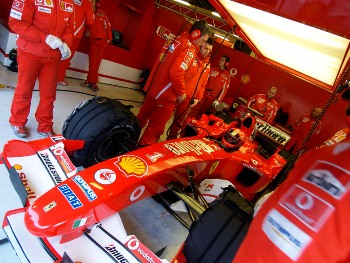|
After Rubens
Barrichello and then Michael Schumacher had their first
drives in the F2005 at Mugello last week, Scuderia Ferrari
Marlboro took the decision to bring two of the new cars to
this weekend’s Bahrain Grand Prix. While each driver will
have an F2005 as a race car, the spare will be one of the
F2004 M, used in the season’s first two races.
It is not just
the drivers who have to adapt to dealing with a new car. The
mechanics, for whom working on the F2004 became second
nature last season, now have to adapt to the differences of
the new single seater. In order to make the transition as
easy as possible, the race team mechanics were responsible
for the initial F2005 build programme, which was planned to
give them experience with the car and they were involved in
the first assembly up until the moment of its first
shakedown test at Fiorano. This ensured they know the base
points of the car, although certain items have changed since
then.
“For Malaysia,
we actually left two members of the race team at home and
brought two of the test team here,” explained Scuderia
Ferrari Marlboro’s Race and Test Technical Manager Nigel
Stepney. “This gives the test guys experience of working at
a race which will be useful if we need some extra people in
the future and also gives the race team people some extra
experience with the new car. The chief mechanic from the
race team attended several early tests with F2005 so that he
has a good working knowledge of the car. Therefore, now that
we are introducing the new car there will be less
surprises.”
Input from the
mechanics goes all the way back to the car’s design stage.
“Items on the old car that maybe gave us some problems or
were difficult to work on are immediately modified for the
new car and that is already happening from the 2005 car to
the one for 2006 so it is a continuous process of
evolution,” reveals Stepney.
“Obviously the mechanics would like their working life to be
as easy as possible, but of course you have to take
performance into consideration and the philosophy and design
of the cars. F1 machines are not the easiest cars to work on
The main thing when you assemble a car for the first time is
to try and pick up as many problems as possible as early as
possible. Over the past years we have been very meticulous
in this area and that pays off, because the F2005 was able
to run for 300 kms on its first day of testing. It is very
satisfying for the people involved not just in the race team
but in all departments as it shows how we have improved
procedures, technology and the way we work."
“Nowadays with
CAD CAM design technology, the car is built on a computer in
3D and you can see the fitting problems straight away and
the design office actually draws up any special tools needed
to get to awkward fixings or nuts and bolts, for example
around the exhausts.”
The hardest area on any car to work on is the fuel system
because of its complexity within the fuel cell. “But these
days, we do very little repair work at the track,” says
Stepney. “We tend to operate by changing entire assemblies
as this is quicker. |
|
 |
|
"Last year, we
reacted very well in Bahrain and we won because we were the
better prepared team" |
|
|
"All the components are so enclosed these days. For example,
you can’t change the spark plugs without taking the floor
and the exhausts off, because of the design concept of the
car. Essentially, there is no point compromising performance
to make the car easier to work on.”
Apart from the
challenge of working with the new car, Scuderia Ferrari
Marlboro, along with all the other teams, will also have to
deal with one feature unique to the Sakhir circuit in
Bahrain: the sand, which attacks every component on the car,
including the engine.
“Last year, for
the first Bahrain race, we saw a lot of stone damage to
parts such as turning vanes and the leading edge of the
floor where the stones get thrown up by the wheels," recalls
Stepney. “It was wearing away the carbon. Last year, we made
modifications to make the car more robust and this year they
were incorporated in the design stage."
“Last year, we
reacted very well in Bahrain and we won because we were the
better prepared team in those conditions. We ended up
working through the night on Friday, because with the parc
ferme rules we could not have done anything on Saturday
night. It involved the whole team, from the tyre men to the
engine and gearbox guys working together, modifying brake
ducts and repairing floors. It is one of our advantages that
we have a group of people that can all work together. When
they finish on the engine and gearbox they could help us
with these extra tasks. We put stone guards on the radiator
exits, because the rear tyres were throwing up stones onto
the back face of the radiators and the small sand particles
were damaging the radiator cores.”
The combination
of introducing the new car and preparing for the difficult
track conditions in Bahrain, will present the Scuderia with
a heavy workload. But Stepney is convinced the team can take
it all in its stride. “Nobody is panicking and everyone will
be working as methodically as ever, because at Ferrari, we
know the importance of being strong as a group.” |
|
![]()
![]()